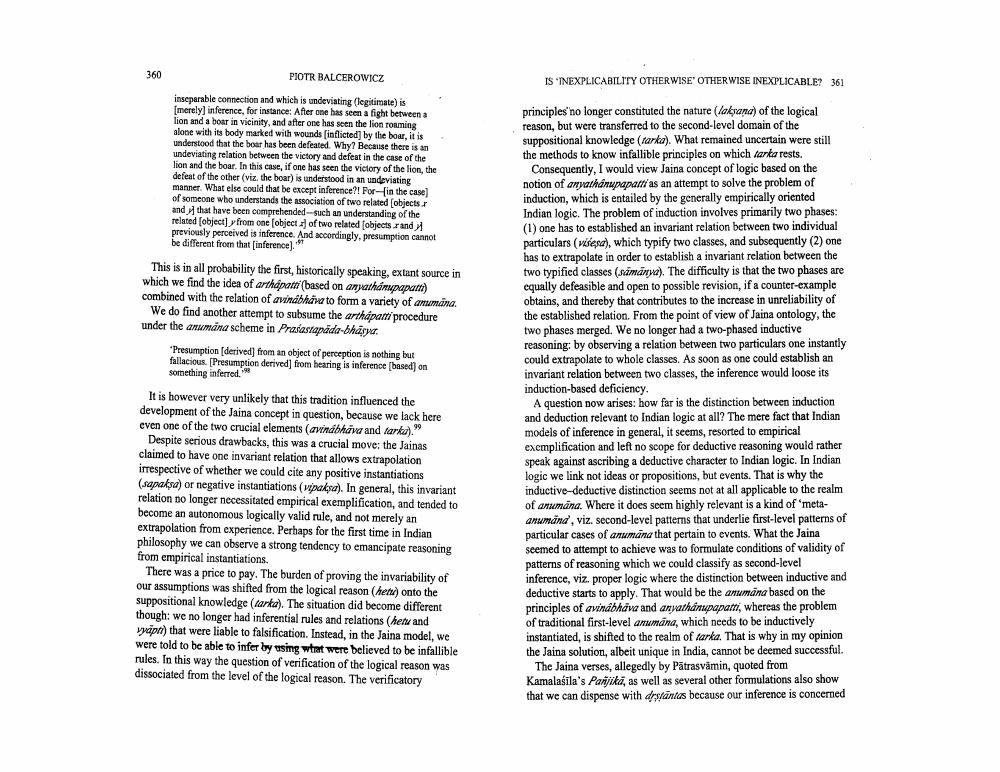________________
360
PIOTR BALCEROWICZ
inseparable connection and which is undeviating (legitimate) is [merely] inference, for instance: After one has seen a fight between a lion and a boar in vicinity, and after one has seen the lion roaming alone with its body marked with wounds [inflicted] by the boar, it is understood that the boar has been defeated. Why? Because there is an undeviating relation between the victory and defeat in the case of the lion and the boar. In this case, if one has seen the victory of the lion, the defeat of the other (viz. the boar) is understood in an undeviating manner. What else could that be except inference?! For-[in the case] of someone who understands the association of two related [objects.r and that have been comprehended-such an understanding of the related [object]y from one [object ) of two related [objects.rand previously perceived is inference. And accordingly, presumption cannot be different from that [inference].
This is in all probability the first, historically speaking, extant source in which we find the idea of arthapatti (based on anyathanupapatti) combined with the relation of avindbhava to form a variety of anumana. We do find another attempt to subsume the arthápatti procedure under the anumana scheme in Prasastapada-bhāsya.
*Presumption [derived] from an object of perception is nothing but fallacious. [Presumption derived] from hearing is inference [based] on something inferred."
It is however very unlikely that this tradition influenced the development of the Jaina concept in question, because we lack here even one of the two crucial elements (avindbhava and tarka)."
Despite serious drawbacks, this was a crucial move: the Jainas claimed to have one invariant relation that allows extrapolation irrespective of whether we could cite any positive instantiations (sapaksa) or negative instantiations (vipaksa). In general, this invariant relation no longer necessitated empirical exemplification, and tended to become an autonomous logically valid rule, and not merely an extrapolation from experience. Perhaps for the first time in Indian philosophy we can observe a strong tendency to emancipate reasoning from empirical instantiations.
There was a price to pay. The burden of proving the invariability of our assumptions was shifted from the logical reason (het) onto the suppositional knowledge (tarka). The situation did become different though: we no longer had inferential rules and relations (het and vyap) that were liable to falsification. Instead, in the Jaina model, we were told to be able to infer by using what were believed to be infallible rules. In this way the question of verification of the logical reason was dissociated from the level of the logical reason. The verificatory
IS INEXPLICABILITY OTHERWISE OTHERWISE INEXPLICABLE? 361
principles no longer constituted the nature (lakyana) of the logical reason, but were transferred to the second-level domain of the suppositional knowledge (tarka). What remained uncertain were still the methods to know infallible principles on which tarka rests. Consequently, I would view Jaina concept of logic based on the notion of anyathanupapatti as an attempt to solve the problem of induction, which is entailed by the generally empirically oriented Indian logic. The problem of induction involves primarily two phases: (1) one has to established an invariant relation between two individual particulars (visesa), which typify two classes, and subsequently (2) one has to extrapolate in order to establish a invariant relation between the two typified classes (samanya). The difficulty is that the two phases are equally defeasible and open to possible revision, if a counter-example obtains, and thereby that contributes to the increase in unreliability of the established relation. From the point of view of Jaina ontology, the two phases merged. We no longer had a two-phased inductive reasoning: by observing a relation between two particulars one instantly could extrapolate to whole classes. As soon as one could establish an invariant relation between two classes, the inference would loose its induction-based deficiency.
A question now arises: how far is the distinction between induction and deduction relevant to Indian logic at all? The mere fact that Indian models of inference in general, it seems, resorted to empirical exemplification and left no scope for deductive reasoning would rather speak against ascribing a deductive character to Indian logic. In Indian logic we link not ideas or propositions, but events. That is why the inductive-deductive distinction seems not at all applicable to the realm of anumana. Where it does seem highly relevant is a kind of 'metaanumand, viz. second-level patterns that underlie first-level patterns of particular cases of anumana that pertain to events. What the Jaina seemed to attempt to achieve was to formulate conditions of validity of patterns of reasoning which we could classify as second-level inference, viz. proper logic where the distinction between inductive and deductive starts to apply. That would be the anumana based on the principles of avindbhava and anyathanupapatti, whereas the problem of traditional first-level anumana, which needs to be inductively instantiated, is shifted to the realm of tarka. That is why in my opinion the Jaina solution, albeit unique in India, cannot be deemed successful. The Jaina verses, allegedly by Pätrasvämin, quoted from Kamalasila's Panjikä, as well as several other formulations also show that we can dispense with distantas because our inference is concerned




